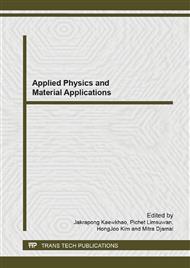[1]
N. Sombatsompop, Effects of crosslink characteristics on density and swelling behavior of expanded natural rubber vulcanizates, Cell Polym. 17 (1998) 63-74.
Google Scholar
[2]
G. Scarinci, G. Brusatin and E. Bernardo, Glass Foams, in: M. Scheffler, P. Colombo (Eds.), Cellular Ceramics: Structure, Manufacturing, Properties and Applications, WILEY-VCH, Weinheim, 2005, pp.158-176.
DOI: 10.1002/3527606696.ch2g
Google Scholar
[3]
H.R. Fernandes, D.U. Tulyaganov, J.M.F. Ferreira, Preparation and characterization of foams from sheet glass and fly ash using carbonated as foaming agents, Ceram. Inter. 35 (2009) 229-235.
DOI: 10.1016/j.ceramint.2007.10.019
Google Scholar
[4]
B. Mangutova, B. Angjuševa, D. Miloševski, E. Fidančevska, J. Bossert, M. Miloševski, Utilisation of fly ash and waste glass in production of glass-ceramics composites, Bull. Chem. Technol. 23(2) (2004), 157-162.
Google Scholar
[5]
T. Kato, K. Ohashi, M. Fuji, M. Takahashi, Water absorption and retention of porous ceramics fabricated by waste resources, J. Ceram. Soc. Japan. 116(2) (2008) 212-215.
DOI: 10.2109/jcersj2.116.212
Google Scholar
[6]
J. Gao, J. Wang, H. Xu, C. Wu, Preparation and properties of hollow glass bead filled silicone rubber foams with low thermal conductivity, Materials and Design. 46 (2013) 491-496.
DOI: 10.1016/j.matdes.2012.08.070
Google Scholar
[7]
J.Z. Liang, F.H. Li, Measurement of thermal conductivity of hollow glass-bead-filled polypropylene composites, Polym. Test. 25(4) (2006) 527-531.
DOI: 10.1016/j.polymertesting.2006.02.007
Google Scholar
[8]
B. Chen, Z. Luo, A. Lu, Preparation of sintered foam glass with high fly ash content, Mater. Letters. 65 (2011) 3555-3558.
DOI: 10.1016/j.matlet.2011.07.042
Google Scholar
[9]
E. Bernardo, R. Cedro, M. Florean, S. Hreglich, Reutilization and stabilization of wastes by the production of glass foams, Ceram. Inter. 34 (2007) 963-968.
DOI: 10.1016/j.ceramint.2006.02.010
Google Scholar
[10]
E. Bernardo, F. Albertini, Glass foams from dismantled cathode ray tubes, Ceram. Inter. 32 (2006) 603-608.
DOI: 10.1016/j.ceramint.2005.04.019
Google Scholar


